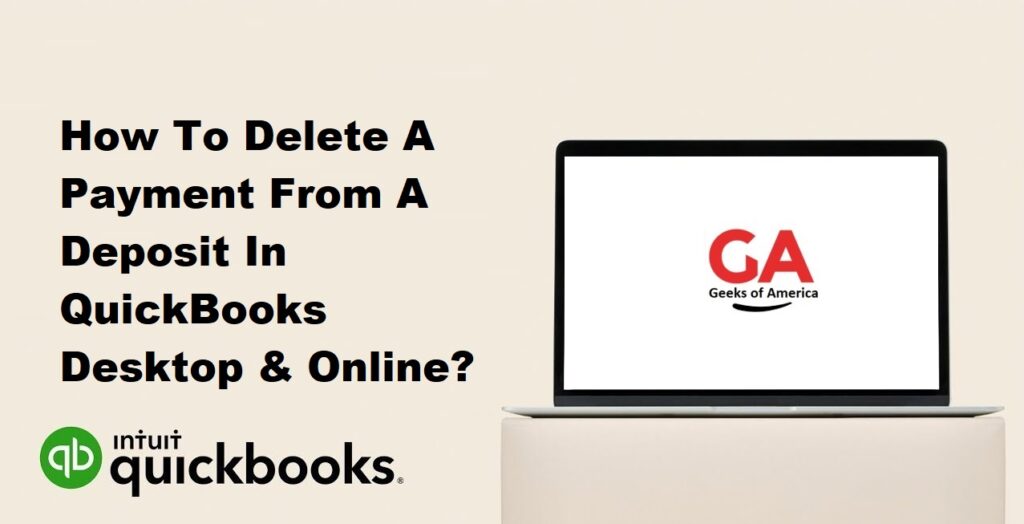Managing payments and deposits accurately is crucial for maintaining precise financial records in QuickBooks Desktop and QuickBooks Online. However, there may be instances where you need to delete a payment from a deposit due to errors, duplicate entries, or other reasons. It is essential to follow the correct process to remove a payment from a deposit to ensure the integrity of your financial data. In this guide, we will walk you through the steps of deleting a payment from a deposit in both QuickBooks Desktop and QuickBooks Online. By following these steps, you can effectively manage your deposit transactions while maintaining accurate financial records.

I. Understanding the Importance of Accurate Payment and Deposit Management:
A. Maintaining Financial Accuracy:
Accurate payment and deposit management is crucial for maintaining overall financial accuracy. It ensures that your financial records are up to date and reflective of the actual transactions that have taken place.
B. Ensuring Reconciliation and Balancing:
Proper payment and deposit management simplifies the process of bank reconciliation and balancing. Accurate records enable you to match payments with corresponding deposits, ensuring accurate reconciliation of accounts.
C. Complying with Auditing and Reporting Requirements:
Accurate payment and deposit records are essential for complying with auditing and reporting requirements. They provide a clear audit trail and ensure accurate financial reporting.
Read Also : How To Delete A Deposit In QuickBooks Desktop & Online?
II. Considerations Before Deleting a Payment from a Deposit:
A. Identifying the Need for Deletion:
Determine the reason for deleting a payment from a deposit. Common reasons include duplicate entries, errors, or payments that should not have been included in the deposit.
B. Analyzing Implications on Financial Records:
Before deleting a payment from a deposit, assess the impact on related financial records such as income statements, bank reconciliations, and tax filings. Consider any potential discrepancies or imbalances that may arise from the removal.
C. Ensuring Backup and Data Safety:
Before performing any deletion, create a backup of your QuickBooks company file to ensure data safety. This allows you to restore the file in case any unintended consequences occur during the deletion process.
Read Also : How To Change Invoice Number In QuickBooks Desktop?
III. Deleting a Payment from a Deposit in QuickBooks Desktop:
A. Locating the Deposit and Payment:
- Launch QuickBooks Desktop and open your company file.
- Navigate to the “Banking” menu and select “Make Deposits.”
B. Reviewing Associated Transactions:
- In the “Make Deposits” window, locate the deposit containing the payment you want to delete.
- Double-click on the deposit to open the details.
C. Deleting the Payment from the Deposit:
- In the deposit details, locate the payment you want to delete.
- Right-click on the payment and select “Delete Line” or “Remove Line” from the context menu.
- Confirm the deletion when prompted.
Read Also : How To Change Invoice Number In QuickBooks Online?
IV. Deleting a Payment from a Deposit in QuickBooks Online:
A. Locating the Deposit and Payment:
- Log in to your QuickBooks Online account and select the appropriate company file.
- Navigate to the “Banking” or “+ New” menu and choose “Deposits.”
B. Reviewing Associated Transactions:
- In the “Deposits” window, locate the deposit containing the payment you want to delete.
- Click on the deposit to open the details page.
C. Deleting the Payment from the Deposit:
- On the deposit details page, find the payment you want to delete.
- Click on the payment to select it, then click the “Delete” or “Trash” icon.
- Confirm the deletion when prompted.
Read Also : How To Connect Shopify To QuickBooks Desktop?
V. Managing Implications and Potential Challenges:
A. Impact on Financial Reports and Reconciliation:
Deleting a payment from a deposit can affect financial reports and bank reconciliations. After deleting the payment, review the impacted reports and update reconciliations accordingly.
B. Addressing Related Transactions and Balances:
Deleting a payment from a deposit may require adjustments to related transactions and account balances. Check for any affected invoices, receipts, or payments, and make the necessary modifications.
C. Ensuring Data Integrity and Accuracy:
After deleting a payment from a deposit, ensure that your financial data remains accurate and balanced. Reconcile accounts and verify that balances and records align with your intended adjustments.
Read Also : How To Delete Vendor In QuickBooks & QuickBooks Online?
VI. Best Practices for Managing Payments and Deposits:
A. Reviewing and Verifying Payments Before Recording:
Double-check payments and their respective deposits before recording them in QuickBooks. Verifying the accuracy of the transactions minimizes the need for deletions.
B. Regular Reconciliation and Review:
Regularly reconcile your bank accounts and deposits to identify any discrepancies or errors. This practice helps maintain accurate records and reduces the likelihood of needing to delete payments from deposits.
C. Proper Training and Documentation:
Provide adequate training and documentation for employees responsible for recording payments and managing deposits in QuickBooks. Clear instructions and guidelines minimize errors and promote consistency in deposit management.
Read Also : How To Record Insurance Claim Payment In QuickBooks Desktop & Online?
VII. Conclusion:
Deleting a payment from a deposit in QuickBooks Desktop and QuickBooks Online requires careful consideration and adherence to the correct procedures. By following the steps outlined in this guide and considering the potential implications, you can confidently manage your deposit transactions while maintaining accurate financial records. Remember to review associated transactions, address related balances, and ensure data accuracy after deletion. Implementing best practices and regular review processes will help minimize errors and maintain accurate payment and deposit management in the long run.
